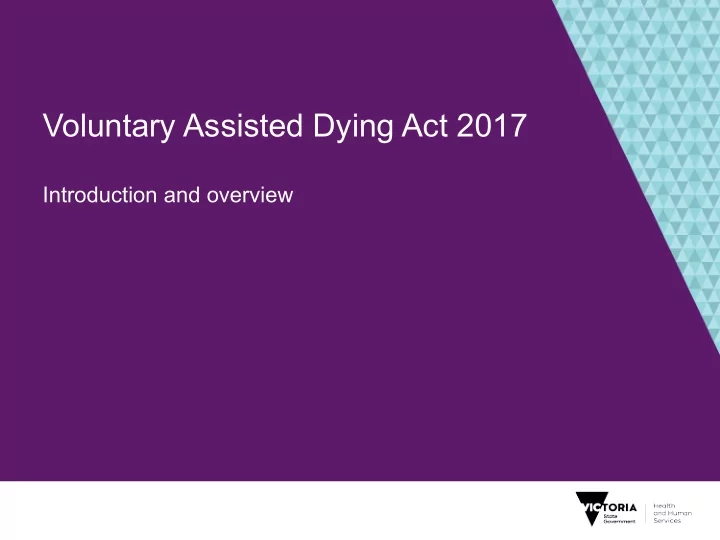

Voluntary Assisted Dying Act 2017 Introduction and overview
Introduction • The Voluntary Assisted Dying Act 2017 was passed by the Victorian Parliament on 29 November 2017 • The Act will commence operation on 19 June 2019 • The Act followed two years of consultation and development, and reflects a balance between giving people choices at the end of their life and ensuring community safety. • The policy in the Act is now settled and the focus has shifted to implementation of the Act.
Guiding Principles • Every human life has equal value. • A person’s autonomy should be respected. • Informed decision making. • Quality care that minimises suffering and maximises quality of life. • Therapeutic relationships be supported and maintained. • Open discussions about death and dying. • Conversations about treatment and care preferences. • Genuine choice balanced with safeguards. • All people have the right to be shown respect for their culture, beliefs, values and personal characteristics.
Voluntary Assisted Dying Act 2017 The Act sets out the legal requirements of voluntary assisted dying. Like any other clinical intervention, there are other considerations that will need to be addressed in practice. The Act provides for and regulates access to voluntary assisted dying in Victoria, it: • Establishes clear eligibility criteria • Steps through a detailed request and assessment process, including requirements for medical practitioners • Sets up a voluntary assisted dying permit process which authorises the prescribing and dispensing of a voluntary assisted dying substance • Establishes the Voluntary Assisted Dying Review Board (Review Board) • Provides for a range of additional safeguards including substance monitoring, practitioner protections, offences, and a five year review.
Eligibility Criteria To access voluntary assisted dying, a person must meet all of the following eligibility criteria: • be aged 18 years or more; and • be an Australian citizen or permanent resident; and be ordinarily resident in Victoria for at least 12 months; and • have decision-making capacity in relation to voluntary assisted dying; and • be diagnosed with a disease, illness or medical condition, that: – is incurable; and – is advanced, progressive and will cause death; and – is expected to cause death within weeks or months, not exceeding 6 months (12 months for people with a neurodegenerative condition); and – is causing suffering that cannot be relieved in a manner the person considers tolerable.
Request and assessment A person must make three separate requests The formal process for requesting voluntary assisted dying is as follows: • The person makes their first request to a medical practitioner (who becomes the co-ordinating medical practitioner if they accept) • The person undergoes a first assessment by the co-ordinating medical practitioner • The person undergoes a consulting assessment by a consulting medical practitioner • The person makes a written request, which is signed by two independent witnesses • The person makes a final request to the co-ordinating medical practitioner • The person’s final request must be made at least 9 days after the day on which they made their first request (exception if they are likely to die within that time)
If the person is eligible • The co-ordinating medical practitioner applies for a voluntary assisted dying permit from DHHS to prescribe the voluntary assisted dying substance. This is an opportunity to ensure compliance with the request and assessment process. • If the person is physically able to self-administer and digest the substance, the practitioner must apply for a self-administration permit. • If the person is not physically able to self-administer or digest the substance, the practitioner must apply for a practitioner administration permit. • Administration by a medical practitioner will only occur in very limited circumstances and will ensure those who are physically unable to self- administer are not discriminated against.
Implementation • Implementation will be within the context of existing care available to people at the end of their life • The Implementation Taskforce is undertaking a range of tasks, including developing: – clinical guidelines (which will step practitioners through legal and clinical requirements) – training (focused on the legal and clinical requirements) – a medication protocol (will be provided to participating medical practitioners and will set out exactly what to prescribe) – consumer and community information (will be available at a range of levels and for a range of situations) – models of care (will assist health services to respond to the new legislation) • This information will be available by March 2019, to ensure people have sufficient time to prepare for 19 June 2019. • There will also be further information sessions and support.
Role of aged care services Services must decide whether or not they will provide support for people seeking information about or accessing voluntary assisted dying. Regardless of whether an aged care service will provide support, it must be prepared for the new legislation. Things to consider include: • How will staff respond to questions and requests for information? • How will staff be supported in managing these requests? • How will you respond to a resident/client who obtains the VAD medication? • How will staff be educated and supported if voluntary assisted dying will be provided at a health service?
Role of aged care services • How will staff respond to questions and requests for information? • How will staff be supported? • How will you respond • to a prospective client who has the medication? • to a resident/client who obtains the VAD medication? • if they want to administer the medication at “home”
Recommend
More recommend